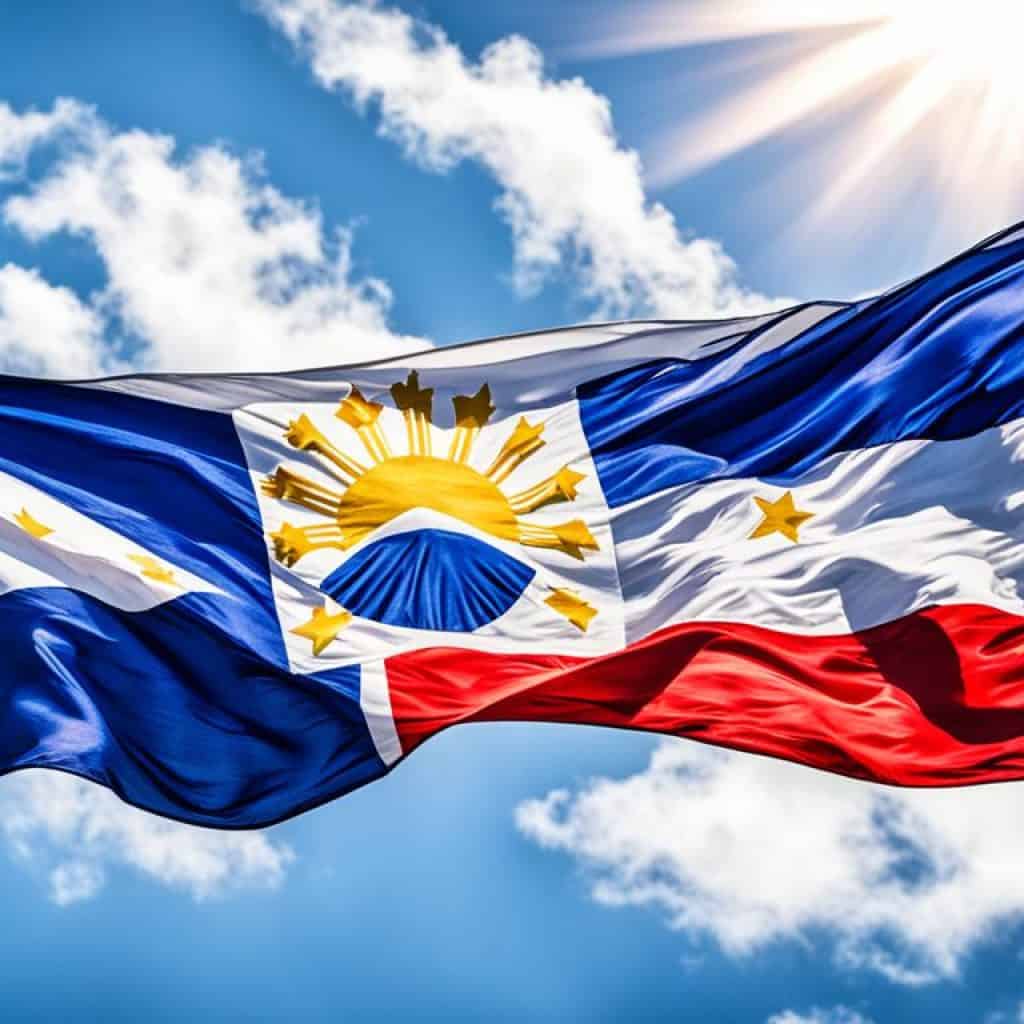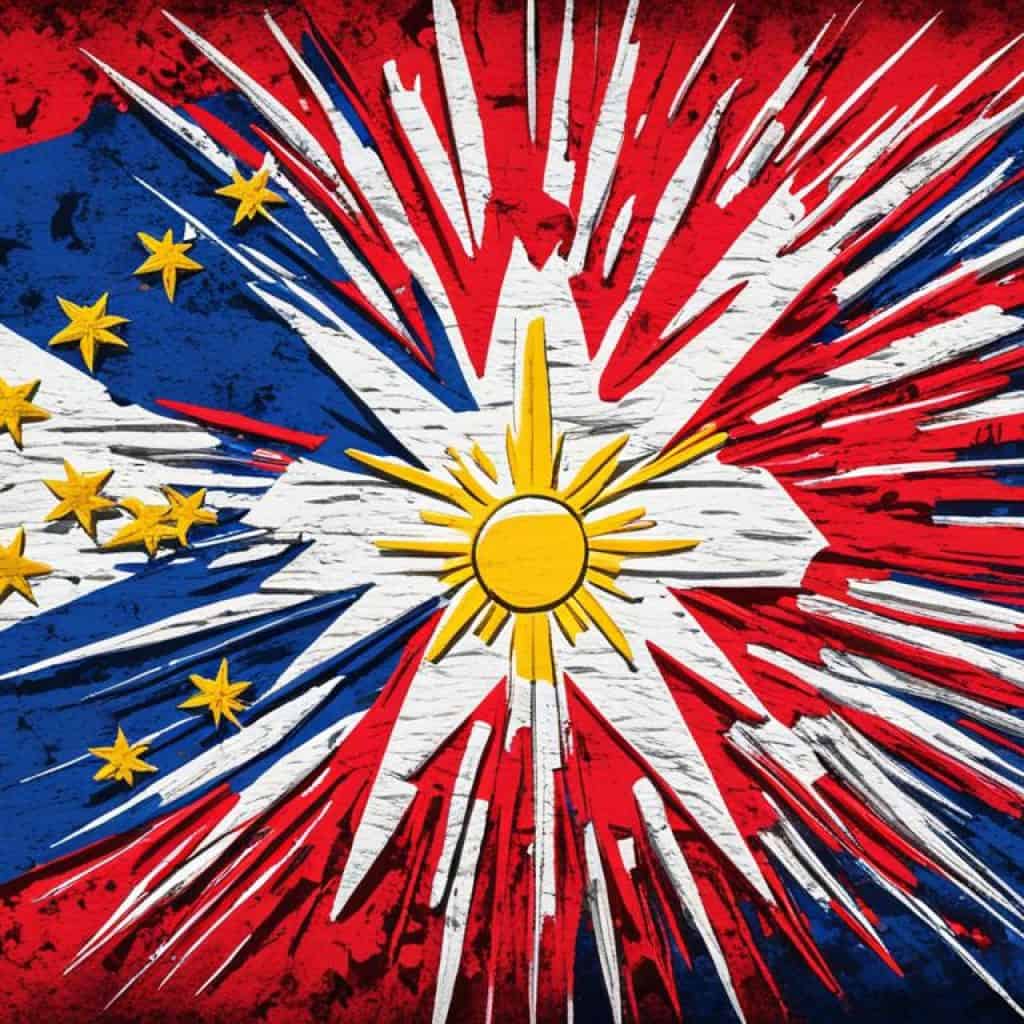Have you ever wondered about the rich history and symbolism behind the War Flag of the Philippines? What do the colors, design, and symbols on the flag represent? Join us on a journey to uncover the fascinating story of the Philippine flag and its deep significance to the Filipino people.
Key Takeaways:
- The Philippine flag is a horizontal bicolor flag with equal bands of royal blue and crimson red.
- The white equilateral triangle at the hoist represents liberty, equality, and fraternity.
- The blue stripe symbolizes peace, truth, and justice, while the red stripe represents patriotism and valor.
- The sun with its eight rays symbolizes the first eight provinces that rebelled against Spanish colonization.
- The three stars represent Luzon, Visayas, and Mindanao, the three main island groups of the Philippines.
Design of the Philippine Flag
The design of the Philippine flag is a carefully crafted representation of the nation’s history and aspirations. The flag possesses distinct characteristics that make it instantly recognizable and symbolically significant to the Filipino people.
The Philippine flag has an aspect ratio of 1:2, with a length twice its width. This unique dimension gives the flag its iconic rectangular shape, making it stand out among other national flags.
The most prominent feature of the flag is the white equilateral triangle positioned at the hoist. This triangle represents the core values of liberty, equality, and fraternity, which are integral to the Filipino identity.
The sides of the white triangle align with the width of the flag, emphasizing its balance and proportion. Such meticulous attention to detail demonstrates the thoughtfulness put into the flag’s design.
At each vertex of the white triangle, three five-pointed stars are placed. These stars symbolize the three main island groups of the Philippines: Luzon, Visayas, and Mindanao. The orientation of each star, with one of its tips pointing towards the vertex, adds to the flag’s visual appeal and the unity it represents.
The use of color in the Philippine flag is equally significant. The shade of blue employed is Royal Blue, evoking feelings of peace, truth, and justice. This color choice reflects the Filipino people’s desire for a harmonious society built on truth and fairness.
The shade of red used in the flag is Crimson Red, representing patriotism and valor. This vibrant color embodies the passion and bravery of the Filipino people, highlighting their unwavering commitment to their nation.
Both the stars and the sun in the flag are Golden Yellow. This color symbolizes wealth, nobility, and hope. The sun, with its eight primary rays, honors the eight provinces that fought against Spanish colonization during the Philippine Revolution.
Republic Act 8491 specifies the official colors of the Philippine flag, ensuring consistency and accuracy in its representation. The design and colors chosen for the flag reflect the Filipino people’s aspirations for a united, just, and prosperous nation.
Symbolism of the Philippine Flag
The Philippine flag incorporates various symbols that hold deep historical and cultural significance to the Filipino people. Each element on the flag represents a different aspect of the country’s history, values, and aspirations:
1. White Triangle: Liberty, Equality, and Fraternity
The white equilateral triangle at the hoist of the flag signifies liberty, equality, and fraternity. It represents the fundamental principles and ideals that the Filipino people hold dear.
2. Blue Stripe: Peace, Truth, and Justice
The blue stripe on the flag symbolizes peace, truth, and justice. It reflects the nation’s commitment to promoting harmony, seeking truth, and upholding the principles of justice.
3. Red Stripe: Patriotism and Valor
The red stripe on the flag represents patriotism and valor. It embodies the courage, passion, and love for country exhibited by the Filipino people throughout history.
4. Sun with Eight Rays: Rebellion against Spanish Colonization
The golden-yellow sun with eight primary rays at the center of the white triangle symbolizes the first eight provinces that rebelled against Spanish colonization. It serves as a constant reminder of the Filipino people’s struggle for freedom and their determination to overcome oppression.
5. Three Stars: Luzon, Visayas, and Mindanao
The three five-pointed golden-yellow stars at each vertex of the flag represent Luzon, Visayas, and Mindanao, the three main island groups of the Philippines. They symbolize the unity and harmony among the different regions of the country.
The symbolism embodied in the Philippine flag reflects the struggles, resilience, and hopes of the Filipino people. It serves as a powerful reminder of their history, values, and aspirations, uniting them under a common national identity.
History of the Philippine Flag
The Philippine flag holds a rich history that reflects the struggles and triumphs of the Filipino people in their quest for independence. Designed by Emilio Aguinaldo, the leader of the Philippine Revolution, during his exile in Hong Kong, the flag carries immense historical significance.
On May 28, 1898, the Philippine flag was first flown during the Battle of Alapan. It symbolized the Filipino people’s determination to break free from colonial rule and fight for their rights and freedom. The flag’s formal unveiling took place on June 12, 1898, in Kawit, Cavite, during the proclamation of independence, marking a pivotal moment in Philippine history.
Throughout the years, the flag endured periods of suppression and recognition under various administrations. During the American colonial period, the flag became a symbol of resistance and unity against foreign influence. The flag’s significance further intensified during the Japanese occupation in World War II when it represented the Filipino people’s unwavering spirit and their struggle for liberation.
Finally, on July 4, 1946, the United States granted independence to the Philippines, and the same flag continued to represent the nation as it embarked on a new era of self-governance and sovereignty.
| Year | Significant Event |
|---|---|
| 1898 | Flag flown during the Battle of Alapan |
| 1898 | Formal unveiling during the proclamation of independence |
| 1946 | Granting of independence by the United States |
The history of the Philippine flag represents the resilience and determination of the Filipino people in their pursuit of freedom and their unwavering commitment to uphold their sovereignty.
Significance of the Philippine Flag
The Philippine flag holds immense significance to the Filipino people as it represents their struggle for independence and the resilience they have shown throughout history. It serves as a powerful symbol of national identity, pride, and unity, reminding Filipinos of their shared history and values. The flag has witnessed the country’s journey towards freedom and its aspirations for progress and prosperity. It continues to be a source of inspiration and a rallying emblem for the Filipino people.
Historical Significance of the Philippine Flag
The historical significance of the Philippine flag lies in its role as a representation of the Filipino people’s fight for sovereignty. The flag was first unfurled on May 28, 1898, during the Battle of Alapan, marking the beginning of the Philippines’ struggle for independence from Spain. It was formally recognized as the national flag on June 12, 1898, when the Philippines declared its independence.
Throughout the years, the flag witnessed the challenges faced by the Filipino people, including periods of foreign occupation and colonization. Despite these difficulties, the flag remained a symbol of resistance, unity, and hope. It became a rallying point for Filipinos striving for freedom and self-determination.
Filipino Flag Design Details
The design of the Philippine flag carries significant meaning and symbolism. The flag features a blue stripe that represents peace, truth, and justice, while the red stripe symbolizes patriotism and valor. The white equilateral triangle signifies liberty, equality, and fraternity.
The flag also includes a golden-yellow sun with eight primary rays, representing the first eight provinces that revolted against Spanish colonization. Additionally, three five-pointed golden-yellow stars are positioned at each vertex of the triangle, symbolizing the three main island groups of the Philippines: Luzon, Visayas, and Mindanao.
The Filipino flag’s design details reflect the country’s history, values, and aspirations. They serve as a visual reminder of the struggles faced by the Filipino people and their unwavering spirit in the pursuit of freedom and progress.

| Flag Element | Symbolism |
|---|---|
| Blue stripe | Peace, truth, and justice |
| Red stripe | Patriotism and valor |
| White triangle | Liberty, equality, and fraternity |
| Golden-yellow sun with eight rays | First eight provinces that rebelled against Spanish colonization |
| Three golden-yellow stars | Luzon, Visayas, and Mindanao |
Connection to Filipino Community and Self
The Philippine flag holds a deep connection to the Filipino community and individuals’ sense of self. It is a symbol of heritage and identity, reminding individuals of their rich history, values, and the sacrifices made by their ancestors. The flag serves as a unifying force, bringing Filipinos together in times of celebration, remembrance, and struggle. It represents the strength, resilience, and pride of the Filipino people, both in their homeland and abroad.
Symbolism of the Filipino Flag
The Filipino flag’s symbolism is deeply rooted in the country’s history and culture. Each element of the flag holds significant meaning:
- The white triangle signifies liberty, equality, and fraternity.
- The blue stripe symbolizes peace, truth, and justice.
- The red stripe represents patriotism and valor.
- The sun with its eight primary rays symbolizes the first eight provinces that rebelled against Spanish colonization.
- The three stars represent Luzon, Visayas, and Mindanao, the three main island groups of the Philippines.
These symbols evoke a sense of pride, unity, and shared identity among Filipinos, both within their local communities and across the globe.
| Symbol | Meaning |
|---|---|
| White Triangle | Liberty, equality, fraternity |
| Blue Stripe | Peace, truth, justice |
| Red Stripe | Patriotism, valor |
| Sun | First eight provinces that rebelled against Spanish colonization |
| Stars | Luzon, Visayas, Mindanao – the three main island groups of the Philippines |
These symbols encapsulate the Filipino spirit, reflecting the country’s history, struggles, and aspirations. The flag serves as a constant reminder of the Filipino people’s strength, resilience, and shared values.
“The Philippine flag represents our unwavering commitment to freedom, justice, and unity. It is a symbol that defines us as a nation and connects us as a community.” – Jose Rizal, Filipino National Hero
The Philippine flag serves as a powerful visual representation of the Filipino people’s identity and sense of self. It is proudly displayed during national celebrations, important events, and gatherings, bringing Filipinos together and fostering a sense of belonging. The flag’s colors, symbols, and historical significance instill a deep sense of pride and unity among Filipinos, both within the country and in diaspora communities around the world. It is a symbol that resonates with every Filipino, connecting them to their roots, their ancestors, and their shared heritage.
Connection to Filipino History
The Philippine flag holds a special place in the country’s history, serving as a witness to the struggles, triumphs, and aspirations of the Filipino people. From its very inception, the flag has been intimately intertwined with the fight against colonization, imperialism, and oppression.
The symbolism embedded in the Philippine flag reflects the deep-rooted desire for independence and freedom that has echoed throughout the generations of Filipinos. The flag stands as a testament to the unwavering spirit of resistance and resilience, showcasing the indomitable will to fight for their rights and reclaim their sovereignty.
In times of darkness and uncertainty, the Philippine flag has been a guiding light, providing hope and inspiration for the Filipino people. It is a symbol of unity and solidarity, reminding them of their shared history and the challenges they have overcome together.
Through the symbolism of its design, the flag speaks volumes about the values and aspirations of the Filipino nation. The white triangle represents the principles of liberty, equality, and fraternity, while the blue stripe signifies peace, truth, and justice. The red stripe represents patriotism and valor, reminding the Filipino people of their unwavering love and commitment to their country.
The Philippine flag stands as a powerful reminder of the sacrifices made by those who came before. It symbolizes the long and arduous journey towards independence and the resilience of the Filipino people in the face of adversity.
Key Historical Events in the Story of the Philippine Flag:
- The creation of the Philippine flag by Emilio Aguinaldo during his exile in Hong Kong
- The first raising of the flag on May 28, 1898, during the Battle of Alapan
- The formal unfurling of the flag on June 12, 1898, during the proclamation of independence in Kawit, Cavite
- The flag’s recognition and suppression during different periods, such as the American colonial period and the Japanese occupation during World War II
- The granting of independence to the Philippines by the United States on July 4, 1946, under the same flag
The Philippine flag’s historical significance is deeply ingrained in the hearts and minds of the Filipino people. It serves as a constant reminder of their rich history, their struggles, and their unwavering spirit.
| Flag Elements | Symbolism |
|---|---|
| White Triangle | Liberty, equality, fraternity |
| Blue Stripe | Peace, truth, justice |
| Red Stripe | Patriotism, valor |
Importance of the Philippine Flag in Filipino Culture
The significance of the Philippine flag in Filipino culture cannot be overstated. It serves as a powerful symbol of national pride, unity, and identity. Whether it is proudly displayed during national holidays, events, or ceremonies, or prominently featured in Filipino households, schools, and public spaces, the flag represents the shared values, history, and aspirations of the Filipino people.
The Philippine flag stands as a visual reminder of the deep respect and reverence Filipinos have for their country and its symbols. It serves as a constant source of inspiration, igniting a sense of patriotism and love for the nation. The flag’s vibrant colors and meaningful symbols evoke a strong emotional connection among Filipinos, instilling a sense of belonging and pride in their rich cultural heritage.
As Filipinos look upon the flag, they are reminded of the sacrifices made by their ancestors in the struggle for independence and the preservation of their freedom. The flag serves as a testament to the resilience, courage, and unwavering spirit of the Filipino people throughout history.
“The flag is the embodiment, not of sentiment, but of history.” – Jose Rizal
The Philippines has a diverse and vibrant culture, and the flag stands at the heart of it all. It is a unifying force that brings Filipinos together, transcending differences and fostering a sense of unity. The flag represents the shared values of loyalty, honor, and respect for one’s country.
Furthermore, the Philippine flag plays a crucial role in shaping the identity of each individual and the Filipino community as a whole. It instills a sense of pride and responsibility, urging Filipinos to contribute positively to their nation’s progress and development.
Indeed, the Philippine flag is not just a piece of cloth; it is a sacred symbol that encompasses the hopes, dreams, and aspirations of the Filipino people. It serves as a constant reminder of the beauty, resilience, and strength of the Filipino spirit.

Centrally positioned, the image above showcases the War Flag of the Philippines. Its bold colors and powerful symbols stand as a testament to the historical significance and enduring importance of the flag in Filipino culture.
The Philippine Flag’s Resilience and Survival
Despite the challenges and tumultuous history the Philippines has faced, the flag has remained a resilient symbol of Filipino identity and resistance. It has survived periods of suppression, conflict, and foreign occupation, proudly flying as a beacon of hope and unity. The resilience of the flag mirrors the resilience of the Filipino people, who have overcome countless obstacles and continue to strive for a better future.
The Philippine Flag’s Role in Nation-Building
The Philippine flag plays a crucial role in nation-building, serving as a powerful symbol that unites the Filipino people. It fosters a sense of national pride, identity, and patriotism, instilling a shared sense of belonging and purpose.
The flag represents the aspirations and values of the Filipino nation, encouraging citizens to work towards a common goal of progress, unity, and social cohesion. It serves as a constant reminder of the sacrifices made by previous generations and the responsibilities of the present and future ones.
Embodying the nation’s history and struggles, the Philippine flag embodies the collective aspirations of the Filipino people. It inspires them to embrace their shared heritage and work together towards a brighter future.
“The Philippine flag is not just a piece of cloth; it is a symbol of our identity, our strength, and our dreams as a nation. It reminds us of the sacrifices made by our ancestors and the responsibility we have to uphold the values they fought for.”
The Symbolic Meaning of the Flag
The Philippine flag’s design and symbolism reflect the spirit of the Filipino people. The white triangle represents liberty, equality, and fraternity, while the blue stripe symbolizes peace, truth, and justice, and the red stripe represents patriotism and valor.
The golden-yellow sun with eight primary rays in the center of the triangle symbolizes the first eight provinces that rebelled against Spanish colonization. The three five-pointed golden-yellow stars at each vertex represent the three main island groups of the Philippines: Luzon, Visayas, and Mindanao.
Together, these elements depict the struggles, resilience, and hopes of the Filipino people, inspiring them to come together and build a prosperous future for their nation.
The Flag’s Impact on National Identity
The Philippine flag holds a significant influence on the national identity of the Filipino people. It serves as a visual representation of the country’s history, values, and aspirations, evoking a strong sense of pride, belonging, and unity.
Displaying the flag during national holidays, events, and ceremonies reinforces the shared values and history of the Filipino people. It serves as a constant reminder of their rich heritage and their continued journey towards a better future.
By embracing the flag, Filipinos reaffirm their commitment to the nation and its progress, contributing to the building of a strong and united Philippines.
| Role of the Philippine Flag in Nation-Building | Indicators |
|---|---|
| National Pride | Reminds citizens of their shared history and achievements |
| Symbolic Importance | Represents the nation’s values and aspirations |
| Patriotism | Instills a sense of loyalty and dedication to the country |
| Unity | Brings people together under a common symbol |
| Social Cohesion | Fosters a collective identity and sense of purpose |
The Philippine flag stands as a powerful reminder of the unique history, identity, and aspirations of the Filipino people. It serves as a beacon of hope and unity, calling on every Filipino to contribute to the nation-building process and create a brighter future for all.
The Philippine Flag’s Impact on Filipino Diaspora
The Philippine flag holds a special significance for the Filipino diaspora, serving as a powerful connection to their homeland and a constant reminder of their cultural heritage. Displayed prominently in Filipino communities around the world, the flag fosters a sense of belonging, pride, and unity among overseas Filipinos.
This cherished flag serves as a source of comfort, identity, and strength to those living far from their motherland. It symbolizes their roots, values, and shared history, acting as a powerful link that transcends geographical boundaries.
Overseas Filipinos display the flag with pride, whether in their homes, workplaces, or community spaces. It serves as a visual representation of their rich cultural heritage and their continued connection to the Philippines.
The Philippine flag holds the power to evoke a deep sense of belonging and identity among the Filipino diaspora. It serves as a visual reminder of the values and traditions that define their community, fostering a sense of unity and camaraderie.
“The Philippine flag represents our shared heritage and reminds us of our roots. It brings us together, serving as a powerful symbol of unity among Filipinos worldwide.” – Maria Santos, Community Leader
“Whenever I see the Philippine flag, I am instantly reminded of my cultural identity and the sacrifices made by our ancestors. It gives me strength and motivation to preserve our heritage and pass it on to future generations.” – Rafael Fernandez, Overseas Filipino
The Philippine flag speaks to the hearts and souls of overseas Filipinos, connecting them to their homeland and igniting their fervor for promoting Filipino culture, values, and aspirations. It serves as a beacon of hope, resilience, and pride among those who carry the Filipino spirit in their hearts, no matter where they may be.
| Benefits for the Filipino Diaspora | Impact |
|---|---|
| A Symbol of Cultural Identity | Strengthens the Filipino diaspora’s connection to their heritage and fosters a sense of pride and belonging. |
| A Reminder of Values and Traditions | Helps preserve and promote Filipino culture, customs, and traditions, even in foreign lands. |
| A Source of Unity and Support | Brings together overseas Filipinos, encouraging collaboration, mutual assistance, and a strong sense of community. |
| A Beacon of Hope and Resilience | Inspires and motivates the Filipino diaspora to overcome challenges, embrace their roots, and strive for a better future. |
The Philippine Flag’s Legacy and Future
The legacy of the Philippine flag is deeply intertwined with the nation’s history and the struggles of the Filipino people. Its symbolism and significance have endured through generations, and it continues to inspire and unite Filipinos today. As the country moves forward, the flag’s legacy remains relevant, serving as a reminder of the past, a guide for the present, and a beacon of hope for the future. The flag will continue to symbolize the Filipino people’s resilience, aspirations, and commitment to progress.
Throughout its history, the Philippine flag has witnessed the country’s journey towards independence, from its first unfurling during the Battle of Alapan to the proclamation of independence on June 12, 1898. It has withstood periods of suppression, recognition, and foreign occupation. The flag has been a source of strength and unity for the Filipino people, representing their collective identity, values, and aspirations.
As the Philippines embraces the future, the flag’s legacy serves as a constant reminder of the sacrifices made by previous generations. It symbolizes the resilience and determination of the Filipino people to overcome challenges and strive for a better future. The flag’s colors, symbols, and meaning continue to resonate with Filipinos, instilling a sense of national pride and solidarity.

The Philippine flag will play a crucial role in shaping the country’s future. It will serve as a unifying force, bringing Filipinos together and fostering a sense of belonging and national identity. The flag will inspire the next generation to carry on the legacy of their ancestors, to continue the pursuit of freedom, progress, and social justice.
As the world evolves, the Philippine flag’s legacy will endure, standing as a symbol of the Filipino spirit and the nation’s rich history. It will continue to inspire Filipinos across the globe and gain further recognition as an emblem of independence, resilience, and pride. The future of the Philippine flag remains bright, illuminating the path towards a united and prosperous Philippines.
The Philippine Flag’s Global Recognition
The War Flag of the Philippines has gained widespread recognition and respect on a global scale. It stands as a powerful emblem, symbolizing the struggles for independence and self-determination of the Filipino people. This recognition is not only due to the flag’s distinctive design but also its rich symbolism.
The Philippine flag represents the deep connection that the Filipino nation holds with the global community. It serves as a visual representation of a country with a remarkable heritage, vibrant culture, and a legacy of resilience and strength. The flag’s recognition on the global stage signifies the pride and unity of Filipinos worldwide.
With its unique design and symbolic significance, the Philippine flag stands as a proud representation of the Filipino people and their shared values. It serves to remind the world of the Philippines’ rich history, its diverse culture, and the enduring spirit of its people.
| Recognition of the Philippine Flag | International Significance |
|---|---|
| The flag’s design has been praised for its symbolism and artistry. | The flag represents the Philippines’ history, culture, and struggle for independence. |
| It holds prominence during international events and gatherings. | The flag serves as a visual representation of the Filipino identity on a global scale. |
| International dignitaries and diplomats pay respect to the Philippine flag. | The flag represents the Philippines’ rich heritage and its significant contributions to the global community. |
The global recognition of the Philippine flag is a testament to its enduring symbolism and the profound impact it has on the Filipino people. It serves as a beacon of pride, identity, and unity for Filipinos around the world, reinforcing their sense of belonging and shared heritage.
The Philippine Flag’s Influence on National Identity
The Philippine flag plays a pivotal role in shaping the national identity of the Filipino people. As a visual representation of the country’s history, values, and aspirations, it holds profound significance and evokes a strong sense of belonging and pride among Filipinos.
The flag’s colors, symbols, and meaning are deeply ingrained in the collective consciousness of the nation, contributing to the development and preservation of a distinct Filipino identity. The bold and vibrant design of the flag represents the courage, resilience, and unwavering spirit of the Filipino people throughout history.
Symbolically, the white equilateral triangle embodies liberty, equality, and fraternity, highlighting the core values that underpin the Filipino society. The blue stripe represents peace, truth, and justice, reflecting the nation’s pursuit of harmony, integrity, and fairness. Meanwhile, the red stripe symbolizes patriotism and valor, reminding Filipinos of their deep love for their country and the sacrifices they have made in its defense.
“Our flag does not only represent a piece of cloth; it is the embodiment of our history, heritage, and the unyielding Filipino spirit.”
Furthermore, the Philippine flag serves as a constant reminder of the Filipino people’s shared heritage and their collective journey towards a better future. It encapsulates the struggles and triumphs of the nation, commemorating the battles fought, the freedom gained, and the challenges overcome.
With its distinctive design and symbolism, the flag fosters unity and solidarity, bringing together Filipinos from different regions, backgrounds, and walks of life. It ignites a sense of pride in one’s roots and fuels a deep sense of responsibility towards fellow countrymen. The flag acts as a unifying force that binds the Filipino people, regardless of their differences, in their shared pursuit of progress and prosperity.
Inspiring Unity and Resilience
The Philippine flag’s influence on national identity extends beyond its visual symbolism. It serves as a source of inspiration, encouraging Filipinos to embody the qualities represented by the flag: resilience, courage, and determination. The flag reminds them of the strength they possess as a nation and the potential they hold to overcome adversity.
Throughout history, the flag has witnessed the Filipino people’s unwavering resolve to protect their sovereignty, fight for their rights, and stand up against oppression. It stands as a testament to their collective spirit and serves as a rallying point for unity during times of celebration, remembrance, and challenges.
The symbolism and significance of the Philippine flag are deeply ingrained in various aspects of Filipino culture, from schools and government institutions to cultural events and sports competitions. It is prominently displayed during national holidays and ceremonies, reinforcing a sense of patriotism, identity, and belonging among Filipinos.
“The Philippine flag is not just a piece of cloth; it is a powerful symbol of our unity, resilience, and shared aspirations for a better future.”
A Table Reflecting the Influence of the Philippine Flag on National Identity
| Aspects | Influence on National Identity |
|---|---|
| Visual Representation | Evoke a strong sense of belonging, pride, and unity among Filipinos. |
| Symbolic Significance | Embody the core values and aspirations of the Filipino people. |
| History and Heritage | Commemorate the struggles, triumphs, and sacrifices of the nation. |
| Unity and Solidarity | Bring Filipinos together, transcending regional, cultural, and social differences. |
| Inspiration and Resilience | Encourage Filipinos to embody the qualities represented by the flag. |
Conclusion
The War Flag of the Philippines, with its distinct design and rich symbolism, encapsulates the storied history and enduring spirit of the Filipino people. From its humble beginnings during the Philippine Revolution to its role as a symbol of national pride and unity today, the flag serves as a powerful reminder of the sacrifices and aspirations that have shaped the nation.
With its equal bands of royal blue and crimson red, the flag’s colors represent peace, truth, justice, patriotism, and valor, while the white equilateral triangle symbolizes liberty, equality, and fraternity. The golden-yellow sun with its eight primary rays represents the provinces that rebelled against Spanish colonization, and the three stars signify Luzon, Visayas, and Mindanao, the three main island groups of the Philippines.
The symbolism and significance embedded in the Philippine flag resonate deeply with Filipinos, both within the country and abroad. It represents their shared history, values, and aspirations for a better future. As a symbol of resilience and national identity, the flag continues to inspire unity and pride among the Filipino people, serving as a constant reminder of their journey towards independence and their commitment to progress and prosperity.
The Filipino flag’s enduring presence in the lives of Filipinos, its recognition on the global stage, and its influence on national identity make it an iconic emblem of the Philippines. As the flag waves proudly in the breeze, it symbolizes the indomitable spirit and unwavering determination of the Filipino people to overcome any challenge and pursue their dreams.














Add comment